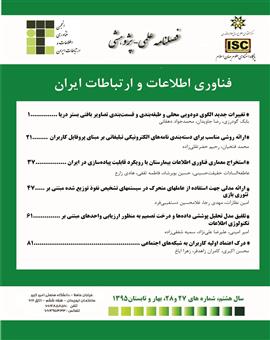ارائه روشی مناسب برای دسته¬بندی نامه¬های الکترونیکی تبلیغاتی بر مبنای پروفایل کاربران
محورهای موضوعی : عمومىمحمد فتحیان 1 , رحیم حضرتقلی زاده 2
1 - استاد علم و صنعت ایران
2 - دانشجو
کلید واژه: تجارت¬الکترونیکی, تبلیغات الکترونیکی, دسته¬بندی هرزنامه¬ها, داده¬کاوی, پروفایل,
چکیده مقاله :
به طور کلی، تعریف هرزنامه در ارتباط با رضايت يا عدم رضايت گیرنده است نه محتوای نامه الکترونیکی. بر طبق این تعريف، مشکلاتي در دسته بندی نامه های الکترونیکی در بازاریابی و تبلیغات مطرح مي شود. برای مثال امکان دارد بعضي از نامه هاي الکترونيکي تبلیغاتی، براي عده اي از کاربران هرزنامه و براي عده اي ديگر هرزنامه نباشد. براي مقابله با اين مشکل با توجه به پروفایل و رفتار کاربران، ضد هرزنامه هاي شخصي طراحی مي شود. به طور عادي براي دسته بندی هرزنامهها، روشهاي يادگيري ماشيني با دقت خوب به کار می رود. اما در هر حال يک روش منحصر به فرد موفق بر مبنای دیدگاه تجارت الکترونیک وجود ندارد. در این مقاله ابتدا پروفایل جدیدی برای شبیه سازی بهتر رفتار کاربران، تهیه می شود .سپس این پروفایل همراه با نامه های الکترونیکی به دانشجویان ارائه شده و پاسخ آنها جمع آوری می گردد. در ادامه برای دسته بندی نامه های الکترونیکی، روشهای مشهور به ازای مجموعه داده های مختلف آزمایش می شود .سرانجام، با مقایسه معیارهای ارزیابی داده کاوی، شبکه عصبی به عنوان بهترین روش با دقت بالا، تعیین می گردد.
In general, the definition of spam is related to the consent or lack of consent of the recipient, not the content of the e-mail. According to this definition, problems arise in the classification of electronic mails in marketing and advertising. For example, it is possible that some promotional e-mails are spam for some users and not spam for others. To deal with this problem, personal anti-spams are designed according to the profile and behavior of users. Usually, machine learning methods are used with good accuracy to classify spam. But in any case, there is no single successful method based on the point of view of e-commerce. In this article, first, a new profile is prepared to better simulate the behavior of users. Then this profile is presented to students along with emails and their responses are collected. In the following, well-known methods are tested for different data sets to categorize electronic mails. Finally, by comparing data mining evaluation criteria, neural network is determined as the best method with high accuracy.
Blanzieri E., Bryl A. ,( 2008) A survey of learning-based techniques of email spam filtering, Artif Intell Rev, vol.29,pp.63–92.
.2 Cukier W. L., Cody S., Nesselroth E. J., (2006)Genres of Spam: Expectations and Deceptions, Proceedings of the 39th Hawaii International Conference on System Sciences, .
.3 Sousa p., et al,(2010) A Collaborative Approach for Spam Detection ,Second International Conference on Evolving Internet, IEEE.
.4 Raad M.,et al,(2010)Impact of spam advertisement through e-mail: A study to assess the influence of the anti-spam on the e-mail marketing, African Journal of Business Management, Vol. 4(11), pp. 2362-2367.
.5 Kim J., Dou D., Liu H., Kwak D., (2007)Constructing a User Preference Ontology for Anti-spam Mail Systems, Canadian AI 2007, LNAI 4509, pp. 272 – 283.
.6 Kakade A.G., Kharat P.K., Gupta A.K,(2013),Survey of Spam Filtering Techniques and Tools, and Map Reduce with SVM, IJCSMC, Vol. 2, Issue. 11, November 2013, pg.91 – 98.
.7 Wenxuan S.,Maoqiang X.,(2013) A Reputation-based Collaborative Approach for Spam Filtering, 2013 AASRI Conference on Parallel and Distributed Computing and Systems, Volume 5, 2013, Pages 220–227
.8 Almeida, T. A., Yamakami, A.,(2012) Facing the spammers: A very effective approach to avoid junk e-mails, Expert Systems with Applications,vol. 39 ,pp.6557–6561.
.9 Cook D., Hartnett J., Manderson K., scanlan J., (2006)catching Spam Before it Arrives: Domain Secific Dynamic Blacklists , ACM Inrenational Conference Proceeding Series; Vol.167,pp.193-202.
.10 Almeida T.A., Yamakami A.,(2010) Content-Based Spam Filtering, The 2010 International Joint Conference on Neural Networks (IJCNN), IEEE.
.11 Ying K.C., et al,(2010)An ensemble approach applied to classify spam e-mails, Expert Systems with Applications.vol 37,pp. 2197–2201.
.12 Saad O., Darwish A., Faraj R.,(2012) A survey of machine learning techniques for Spam
filtering., International Journal of Computer Science and Network ecurity, VOL.12 No.2, February.
.13 Yih W., McCann R., Kołcz A.,(2007) Improving Spam Filtering by Detecting Gray Mail, In Proceedings of the 4rd Conference on Email and Anti-Spam.
.14 Rossiter J. R., Bellman S.,(2005) “Marketing Communications” Prentice Hall, English.
.15Youn S., McLeod D.,(2009) Spam Decisions on Gray E-mail using Personalized Ontologies, Proceedings of the 2009 ACM Symposium on Applied Computing (SAC), Honolulu, Hawaii, USA, pp. 1262-1266.
.16 Guzella T.S., Caminhas W.M.,(2009) A review of machine learning approaches to Spam filtering , Expert Systems with Applications,vol. 36,pp.10206–1022.
.17Saad O.,Darwish A.,faraj R.,(2012)A survey of machine learning techniques for Spam filtering., International Journal of Computer Science and Network security, VOL.12 No.2, February.
.18 Dwork C., Naor M.,(1992) Pricing via processing or combatting junk mail, In Advances in Cryptology - Crypto 92 Proceedings, Springer Verlag, pp 139–147.
.19 SHI L., WANG Q. , MA X. , WENG M. , QIAO H.,( 2012) Spam Email Classi_cation Using Decision Tree Ensemble, Journal of Computational Information Systems,vol. 8: 3,pp. 949–956.
.20 Spam definition.(2012)Availabe at http://en.wikipedia.org/wiki/Spam_(electronic) .
.21 GrayEmail definition,( 2012) Availabe at http://en.wikipedia.org/wiki/Graymail_(email).
.22 Ravi J., Shi W., Xu C., (2005)Personalized Email Management at Network Edges, IEEE Internet Computing, Vol.9(2) ,pp.54-60.
.23 Nicola L.,( 2004) European union vs. spam: A legal response, In Proceedings of the First Conference on Email and Anti-Spam, CEAS’2004.
.24Rafiqul I., Jemal A.,(2013) A multi-tier phishing detection and filtering approach, Journal of Network and Computer Applications, Volume 36, Issue 1, January 2013, Pages 324–335


